By Krista Kurlinkus and Alisha Verly-Jensen
The U.S. government is one of the largest grantmakers in the country. Every year, various government agencies release billions of dollars in funding for nonprofits, public school systems, medical centers, universities, and other civic organizations to carry out their programs and conduct research. Federal grant writing requires a lot of upfront preparation and can take hours to complete. However, since grant awards can amount to six figures or more, for eligible organizations, a federal grant may be the ideal way to seek sustainable funding.
In this article, you’ll learn:
- What federal grants are;
- Why you would want to receive one;
- How to find them;
- How to determine whether a federal funding opportunity is a good fit for your work;
- How to prepare yourself and your team to write one; and
- Strategies for writing the three most difficult parts of federal grant applications.
Writing a large federal grant proposal may feel like jumping into the deep end if you’re new to the world of grant writing. But don’t worry; even if you’re not ready to write one, it’s good to know what’s out there and what the process looks like.
What is a federal grant?

Federal grants are grants that are issued by federal agencies. There are 26 primary agencies that issue grants, including the US Department of Agriculture, the Department of Education, the National Endowment for the Arts, and the National Science Foundation. A good place to start the search for federal grants is Grants.gov. There, you can filter through opengrant opportunities by agency, category of funding, keywords, or eligibility.
Why would an organization want to apply for a federal grant?
There are many reasons that an organization might want to apply for a federal grant. First of all, they are usually much larger than foundation grants. They often range from $100,000 to several million dollars. That amount of capital can go a long way towards getting a big new project off the ground.
Second, securing a federal grant is a great way to demonstrate your organization’s capacity and use that to leverage other development efforts, including funding from donors and foundations. Having a federally recognized program can encourage donors and foundations to jump on the bandwagon and pledge their support to your organization.
Finally, federal grants can be awarded to all types of entities. For example, some federal grant opportunities are only available to small businesses, while others can be split between nonprofits, state and local governmental agencies, and institutes of higher learning. You can find this information and more in the listing on Grants.gov.
So, I’ve decided to apply for a federal grant. How do I start?
First, you’ll need to read the funding opportunity announcement (FOA) thoroughly. We recommend that you print this off and read it with a pen and highlighter in hand. That way, you won’t miss information that you might skip over if you were to read it digitally.
Then you’ll want to make a note of several parts of the listing, including eligibility requirements, description of work to be performed, the award amount, the award period, due dates, and cost sharing or matching funds requirements. Also take note of how to submit your application and any documentation requirements, including DUNS numbers and CAGE codes.
Use this free template from Grant Writing Made Easy to take notes on the grant opportunity and plan next steps for writing your proposal.
Now that I’ve read and made notes on the announcement, where do I go from here?
You’ll want to meet with your team to design a program that meets the requirements of the grant listing. Make these decisions as a group, since the individuals in your organization will have valuable perspectives as you design the program. For example, your program directors will know how to describe the goals and outcomes of the project, while the financial director will know how to translate these ideas for activities into numbers to use on the budget.
If you’re writing the grant proposal collaboratively, it will be very important to decide who is writing what portion early on and to assign due dates for these sections that are far in advance of the actual application due date. Then you’ll want to check up with the team once or twice a week as the deadline approaches.
Depending on the project, you may be required to submit supporting documents, such as expense estimates, building plans, written support from municipal and regional agencies, or job descriptions. Get started on any documents that require collaboration from people outside of your organization since it can be difficult to put together these types of materials last minute.
The federal grant that I’m applying for requires letters of support and matching funds. How do I get these?
To begin, write a 1- to 2-page description of the project. You can use these to make pitches to your stakeholders. If you don’t have any stakeholders, research nonprofits, government agencies, and individuals who will benefit from your program or would like to collaborate on the project. I recommend that you reach out with more than an email; give them a phone call or meet with them in person, if possible. Pound the pavement.
What if I have questions about the grant listing?
You will have questions about the grant listing. But the great news is that there are plenty of ways to get these answered. During the application period, there will be online webinars and in-person workshops. These are ideal opportunities for asking clarifying questions.
We also recommend that you send an email to the contact person on the grant listing to see if your project is a good fit. You can also schedule a phone call to ask any questions you may have. We promise even though this might sound overzealous, these steps are essential.
In the case of federal grants, the contact person expects to hear from applicants and is there to guide you. Though they usually cannot give advice for your specific program, they can provide really good insight into the type of projects that the agency is interested in funding and common pitfalls you should avoid. With this information, you can tweak your project to better fit what the grantmaker is looking for.
When do I start actually writing the proposal?

Now that you’ve done your research, developed a project, found interested stakeholders, and gotten your questions answered, it’s time to begin writing!
We recommend that you start with the statement of need section. Writers sometimes assume this section is about why your organization needs the funding.
This is a misunderstanding. The statement of need should focus solely on the issues within the community or demographic that your program will address. You should clearly describe the causes and repercussions of the problem or challenge.
Remember, reviewers may not be familiar with the area that you deliver services, so you must be as detailed as possible.
This section will require secondary research to support your argument. For example, we recently wrote a grant for economic redevelopment in Appalachia.
To prove the need for the project, we conducted research on the primary impacts of the loss of coal mining jobs on the region. We looked at unemployment statistics, per capita income decline, and losses in tax revenue. We also found data on the secondary impacts of the economic decline, including out-migration and lower overall health.
For federal grants, it’s ideal to use data from federal sources, such as the U.S. Census Bureau, the U.S. Bureau of Labor Statistics, or the National Center for Education Statistics.
Reports produced by local and regional government agencies, any of the Big 4 accounting firms, or highly-respected universities are also valuable data sources. Since a lot can change in a year’s time, try to include only the most up-to-date statistics.
Then, you’ll need to show how the project you are proposing will help the situation.
Doing this will require more statistics and economic theory. For example, while writing the grant for economic redevelopment in Appalachia, we had to prove that the program would have a ripple effect and improve the health of other industries.
The budget will also be time consuming, since the application may require the same information in several different formats. There might be a required budget narrative, an Excel spreadsheet, and an online form. Since that is a time consuming process you’ll want to have your matching funds all figured out before you begin to create your budget.
Another important guideline for creating your budget is to keep your numbers consistent.

Finally, you’ll want to have your numbers all decided before you begin to enter them on the online form.
Another important and challenging section is the program design. It can be tough to translate the project you have pictured in your mind into the written word. The program design should include a concise, yet in-depth explanation of how your project will work and who it will serve.
Filling in a theory of change diagram can help you flesh out your program design.
First think about all of the activities you do within the project.
For example, a literacy-focused nonprofit may perform activities such as organizing low-cost book fairs and hosting child literacy workshops for parents. Then think about the ideal outcome for every activity. What do you hope will change immediately as a result of your activities?
For the literacy program, the staff may aim to increase the number of books local children have in their home or the number of hours parents report reading to their child per week.
The next step is to consider how will those changes affect your target population long-term. In the same example, parents may feel more confident supporting their children’s literacy development and their children may perform better in school.
Being able to articulate all of these points will enable reviewers to understand what you will do, how your program will impact your intended beneficiaries, and the long-term effects of these impacts.
This advice goes for the entire proposal, but especially for this section: Have an outsider who is unfamiliar with the project read what you’ve written and articulate it back. If this person cannot understand your program design, the federal grant maker will not be able to either.
Want to learn more about writing your federal grant? Check out our comprehensive online grant writing course, Grant Writing Made Easy.
We hope that you’ve found this informational and inspirational!







